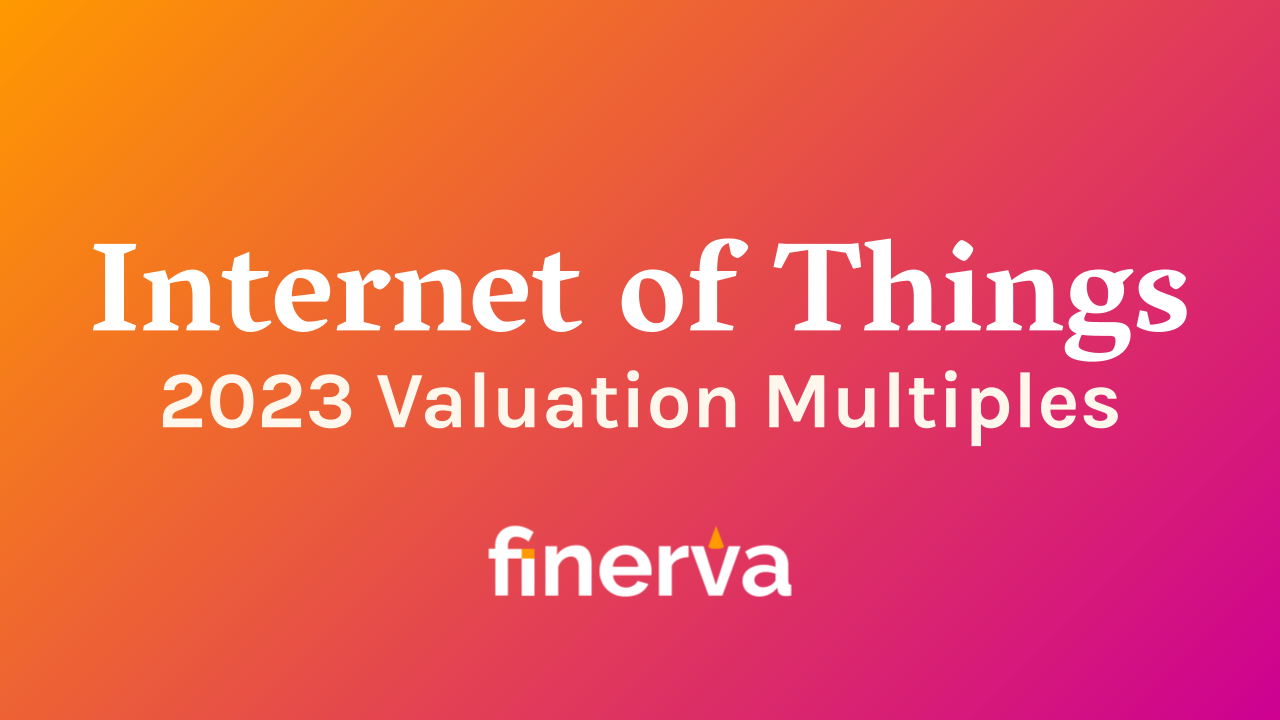Internet of Things (IoT): 2023 Valuation Multiples

Internet of Things is the collective noun used to describe the technology sector dealing with connected devices and sensors. These devices—including smart speakers, tracking tags, smart cameras and many more—are at the forefront of the push for embedding tech into our everyday life.
Because of its underlying aim to extend the vast communication and computing potential of existing internet and cloud technologies, Internet of Things is a sector in constant expansion. Connected speakers with smart-home features were perhaps the first widespread examples of IoT taking a market by storm, followed by smart doorbell like Amazon’s Ring.
More recent trends include anything from wearable sensors (monitoring sleep, athletic performance, glucose levels…) to supply-chain tracking (smart logistics) and real estate monitoring (smart buildings).
Fortune Business Insights reports that the global IoT market was worth over $544bn in 2022, and projected to surpass $3tn by 2030. Among the technological developments that are contributing to IoT’s staggering growth, the main two are the rise of 5G adoption and the development of edge computing.
The Internet of Things ETF (SNSR), managed by Mirae Asset Group, seeks to invest in “companies that stand to potentially benefit from the broader adoption of the Internet of Things (IoT) […] This includes the development and manufacturing of semiconductors and sensors, integrated products and solutions, and applications serving smart grids, smart homes, connected cars, and the industrial internet.”
The 47 companies in the fund are all listed on public stock exchanges, and so their financial metrics may differ from younger start-ups introducing innovative technologies, typically considered a high-risk-high-reward investment. Around 90% of these companies recorded positive revenues throughout the past 2 years, and over 75% had a positive EBITDA.
Internet of Things (IoT) Valuation Multiples
2020 saw Revenue multiples for IoT companies nearly double from 2.3x in Q1 2020 to 4.1x in Q1 2021.
Revenue multiples for the sector have remained relatively stable around the 4x mark throughout 2021, peaking at 4.2x in Q3 2021 before falling—in line with the broader market—until Q3 2022. The median EV/Revenue multiple for IoT companies in Q4 2022 was 3x, 25% above pre-pandemic levels.
Source: YCharts
While these multiples are not as high as some of the sectors adjacent to IoT—for example SaaS or CyberSecurity— they showed consistent growth over the past years and they didn’t show as sharp of a decline as those seen in other industries.
In terms of distribution, this metric also shows a lot of consistency, with the median half of the companies in the cohort (excluding the top and bottom 25%) achieving EV/Revenue multiples roughly between 2x and 4x, while very few outliers surpassed the 10x or even 15x mark.
Source: YCharts In the chart above, the lines indicate the range of EV/Revenue multiples in our cohorts, while the boxes highlight the Interquartile Range (IQR), which is where the median 50% of the cohort ranks based on their valuation multiple.
The high percentage of public IoT companies with positive EBITDA allows us to calculate multiples based on this profit metric with a certain reliability which is not always granted in the tech sector.
Similar to their revenue counterparts, EV/EBITDA multiples for the Internet of Things sector grew from 11.2x to 18x between Q1 2020 and Q1 2021, which was the peak quarter for this metric.
In Q4 2022, the median EV/EBITDA multiple for IoT companies was 13.3x.
Source: YCharts
EBITDA multiples seem to be more competitive with other tech sectors, showing that investors reward companies with proven paths to profitability in an industry where scalability is at the very core of any viable business.
For some IoT companies EV/EBITDA multiples can get even higher, with the top 25% of the cohort ranging from 20x to nearly 90x over the course of the past year.
Source: YCharts In the chart above, the lines indicate the range of EV/Revenue multiples in our cohorts, while the boxes highlight the Interquartile Range (IQR), which is where the median 50% of the cohort ranks based on their valuation multiple.
The information available on this page is of a general nature and is not intended to provide specific advice to any individuals or entities. We work hard to ensure this information is accurate at the time of publishing, although there is no guarantee that such information is accurate at the time you read this. We recommend individuals and companies seek professional advice on their circumstances and matters.




